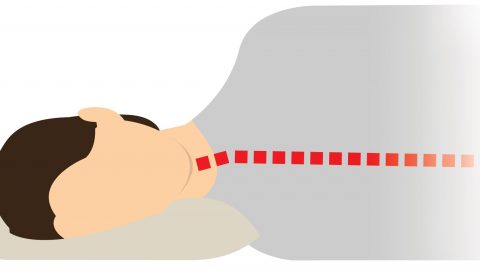
This stomach sleeper quietly dreams, “%#&$! the PRESSURE on my discs, muscles and nerves is extremely irritating.”
Sleep experts agree: sleeping on your stomach is going to kill you!
Well, not really, but stomach sleeping is pretty rough on your sad, aging spine. Why?
Your spine is happiest when it’s aligned in what’s called a “neutral” position. Neutral alignment keeps all the bits and pieces in your back in in their ideal positions, preventing unnecessary pressure on your discs, muscles and nerves. Keep your spine neutrally aligned and you’ll avoid discomfort (or worse).
Unfortunately it’s hard to achieve anything resembling neutral alignment when sleeping on your stomach.
Lying on your stomach inevitably results in awkward bends and twists in your spine’s natural curves that can lead to discomfort:
- Most pillows force your neck into an uncomfortable upward bend
- Your hips may sink too deep into your mattress creating an unnatural downward bend in your lower back.
- Further exacerbating these contortions, your neck has to be turned ninety degrees to the left or right (you can’t breath into your pillow, after all).
All this unnecessary stress and pressure in your back and neck can result in pain that persists during the day.
You could learning to sleep on your side, or your back but…
What if you don’t want to stop sleeping on your stomach?
Let’s face it, changing your sleep position isn’t easy. We sleep the way we do for a reason; it’s comfortable (at least initially). If you’re set on sticking with your stomach sleeping routine, make the most of it with the following tips:
1. Eliminate the bend in your lower back.
The middle of your body is where you’re carrying most of your weight. Thus, your pelvis tends to sink into your mattress farther than your upper and lower extremities. This can cause the lumbar section of your back to fall out of its neutral position. Your hips may sit too low, resulting in unnecessary pressure on the discs, muscles and nerves in your back.
You can reduce the pressure in your lower back by:
- sleeping with a pillow under your hips. This will keep your pelvis slightly elevated off the mattress’s surface, helping to eliminate the excessive downward bend in your back. Experiment with the pillow’s height (loft). An adjustable pillow type that allows fill to be added or removed to your preference will make determining proper loft a breeze (more on that below). Admittedly, sleeping with a pillow under your waist can be a little awkward, so you should also consider…
- sleeping on a firmer mattress type. A mattress that is too soft (we’re looking at you, pillow top mattresses!) will often make lower back pain worse, as your pelvis will not get proper support. A new mattress is expensive of course, so we recommend that you first experiment with the pillow solution above. If that improves your sleep, you can make some reasonable assumptions about the benefits of a new mattress.
2. Try an adjustable pillow (or none at all).
Most traditional pillows are simply too thick for sleeping on your stomach; they’ll force your neck to bend upwards too far.
First, try tossing your pillow aside and sleeping without it. This can help keep your neck positioned more appropriately than using a pillow that’s too thick.
For most stomach sleepers, going sans pillow probably doesn’t feel right. If not, you’ll want to try a thinner, low loft pillow type. More specifically, you’re best off with an adjustable pillow that allows its fill to be added or removed via a zippered opening. This will allow you to fine tune it to your preferences so that it’s not too thin or too thick.

Child’s Pose for praying to the sleep gods (and stretching your back)
3. Relax for a bit in the “child’s pose” when you wake up:
- Sit with your shins to the floor, toes pointed backwards,
- push your pelvis downward,
- reach forward with both hands touching the floor and
- alternate your reach slightly from left to right to extend both sides your back.
Be careful not to overdo it. Pushing just a bit too far can easily result in injury.
Determined stomach sleepers can get their rest (hopefully).
If you can pull it off, we advise that you try adjusting to another sleep position. If you’re happy on your stomach, squeeze our tips into your sleep routine to maximize the rest you’re getting.
Got some good ideas of your own? Let us know in the comments below!





